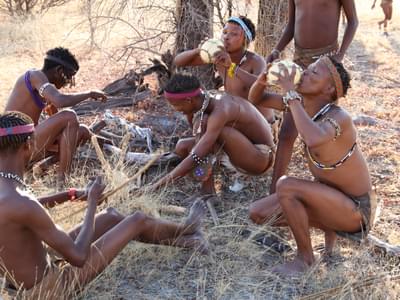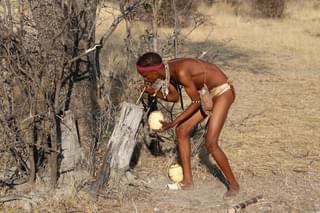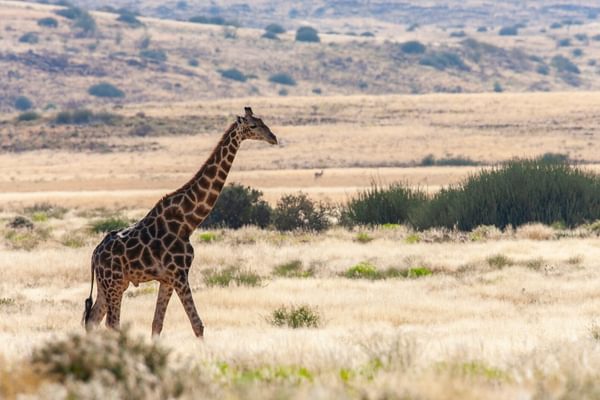Speak to a Namibia expert today
and start planning your tailor-made holiday

Alistair


Can't decide where to go? Why not peruse some of our most popular destinations for inspiration then give us a call!

A diverse land brimming with superb safaris, pristine sandy beaches, towering snow-capped peaks and tropical underwater worlds is just waiting to welcome you

Australia offers vibrant cities, diverse landscapes, and iconic wonders like the Great Barrier Reef. New Zealand adds dramatic scenery, Maori culture, and relaxed charm. Together, they promise nature, adventure, culture, and warm hospitality.

If you're dreaming of an island getaway, look no further than the Caribbean with its gorgeous soft sand beaches and lively, diverse cultures.

Head to the amazing destination that is Central America, full of the knowledge of ancient civilizations, incredible mountains, and beautiful beaches.

Discover vibrant cultures, pristine beaches, and tantalizing flavours in the captivating travel haven that is East and Southeast Asia

Embark on a journey through the vibrant tapestry of India, Sri Lanka, and Bhutan—where ancient temples, lush tea plantations, and soaring Himalayan peaks promise unforgettable moments at every turn.

Picture yourself basking on sun-kissed beaches, sipping tropical cocktails beneath swaying palms —where crystal-clear lagoons and luxurious resorts cater to your every desire.

Experience world-class hospitality, mouthwatering cuisines, and the region’s deep-rooted cultural traditions for an unforgettable Middle East adventure.

Venture to the ends of the Earth and behold the icy majesty of polar landscapes. Discover pristine solitude, exhilarating expeditions, and breathtaking views that promise a memorable encounter with nature at its most dramatic

Journey into the heart of South America, where the rhythmic pulse of its vibrant cities meets the majesty of the Amazon rainforest and the timeless wonder of ancient civilizations.

The South Pacific is a paradise of turquoise waters, white-sand beaches, and vibrant island cultures. From adventure and natural beauty to pure relaxation, each island offers its own unique charm and welcome.

From the soaring plains of the Southwestern USA to the stunning landscapes of the expanses of Canada, visit some of the most impressive scenery in the world

If you are looking for a trip to knock iconic locations off your bucket list, check out our buck list recommendations

From the graceful stride of giraffes at sunrise to the echoing roars of lions beneath starlit skies, each of our safaris promises an unforgettable dance with nature.


Our family holidays are a perfect opportunity to create lasting memories, whether exploring new destinations or simply enjoying quality time together. From adventure-filled escapes to relaxing beach retreats, they offer a chance to reconnect and unwind away from daily routines.

Our luxury holidays offer the finest experiences, from exclusive resorts and private villas to tailor-made adventures with impeccable service.

For those seeking adventure beyond the usual tourist trails, our off-the-beaten-track trips take you to some of the world’s most remote and untouched destinations, where authentic cultural encounters and breathtaking landscapes await. Let us craft your unique journeys that few travellers ever experience.

For the ultimate beach escape, we offer luxury holidays to some of the world’s most stunning coastal destinations, from the white-sand shores of Antigua to the turquoise waters of Zanzibar.

For those who crave excitement and exploration, our adventure holidays take you to some of the world’s most thrilling destinations, whether trekking through Patagonia, summiting Mount Kenya, or kayaking past icebergs in Antarctica.

Interested in something a bit more focused? How about a horse-riding holiday through Argentina? Or a photography safari? Look through our Special Interest holiday selection for inspiration

Our wildlife holidays invite you to step into unique ecosystems and experience amazing animal encounters. Whether spotting majestic tigers in the jungles of India or marvelling at polar bears in the Arctic, each trip promises awe-inspiring moments steeped in the magic of nature.

Our small group tours offer the perfect balance of expert-guided exploration and personal experience, taking you to incredible destinations with like-minded travellers. Whether it's a wildlife safari in Botswana, a cultural journey through Vietnam, or a chef-led expedition through India, our carefully curated itineraries ensure an intimate, enriching, and hassle-free experience.

Sustainability travel is at the core of what we do and a guiding principle in every choice we make as a business. Let us help you make sustainable travel choices

Read about what we do to make a difference

One of the most important parts of our commitment to responsible travel is protecting our clients, and it is a part that we take extremely seriously.

Not sure what's best for which time of year? Check out our expert-written guides

Looking for some expertise on your destination? Have a look through our selection of guides and articles written by our destination experts

Looking for more inspiration? Read from our range of hundreds of articles from our travel specialists, local guides, and personal travel tales.

Our mission is to make every holiday special. We will do this whilst specifically aiming to minimise the environmental impact of our activity and maximise our opportunity to influence others to do the same.

Namibia’s history stretches back to 25,000 BC, when predecessors of the present-day San Bushmen settled in the Huns Mountains in the southern part of the country, with the area home to some of the oldest rock-art sites in the world. Further north, in the Brandberg Mountains of Damaraland, there are rock art sites that date back to 2,000 BC, including the famed White Lady of the Brandberg, although debate still rages as to whether these sites were created by the San Bushmen or the indigenous Damara people who also lived in the area.
More recently, the modern-day tribes of Namibia, namely the Ovambo, Kavango, Himba and Herero, all Bantu speaking people migrated here from Angola, Zambia and the lakes of East Africa. These migrations took place as far back as the 17th Century, with the tribes originally settling in the north-west of the country, before moving further south in the 19th Century. The Himba however have remained in this Kaokoland region, with a visit to this region offering the best chance enjoy a genuine cultural interaction with this fascinating nomadic tribe.

Aside from a few localised tribal conflicts, Namibia remained a relatively peaceful land, right through to the 1830s when its era of turbulence began. The catalyst for this was the movement of Boer farmers through the northern part of South Africa. They were moving as part of the Great Trek, a mass migration away from the Cape to escape the burden of taxation and laws from the newly installed British Government of the Cape. As the Boers reached the Orange River, they encountered a tribe of indigenous Khoisan people, known as Oorlams who were forced across the river and into modern-day Namibia. The Oorlams adopted a number of Boer customs, most notably an adaptation of their language as well as their use of guns, the latter of which eventually forced them into conflict with the Nama and Herero people, the original settlers of the area. The superior firepower of the Oorlams with their modern weapons led to the death of many of the indigenous people and started a long history of conflict between settlers and the tribes of Namibia.
German South-West Africa
German interest in Namibia started as far back as 1840, initially in co-operation with the British as the London Missionary Society worked in conjunction with the German Rhenish Missionary Society to bring their beliefs to the people of Namibia. Tensions began to arise in 1878 when the Germans started to make claims to annexe the deep-water port of Walvis Bay, a key stopping point for British ships on their route to the colonies of south and eastern Africa. The situation escalated in 1883 as Adolf Luderitz purchased the town then known as Angra Pequena from a local Nama chief, renaming it as Luderitz and establishing a German port there. In 1884 the German Chancellor, Otto von Bismark decaled the land a German colony, renaming it as German South-West Africa. Germany further strengthened its hold on the country in 1890 when it took control of the region now known as the Caprivi Strip, in an initially amicable exchange with Britain, ceding their claims to the east African island of Zanzibar in return. The discovery of diamonds along the coast meant that the area became a hugely valuable source of income for the burgeoning German Empire. However, this control inevitably led to conflict, particularly with the Herero people, culminating in the battle of the Waterberg in 1904. The conflicts led to between 24,000 and 65,000 of the Herero losing their lives, with many others feeling across the borders. Indeed, as recently as 2007 the descents of the German leaders of the time apologised in full to the Herero people for the conflict and the impact it had on their people.
FACT – The German influence in Namibia is still evident today in the architecture of many of the buildings, especially in Windhoek.
Herrero-German Genocide
The German depredations of Namibia’s indigenous Herero population took place between 1904 and 1908, making them the first genocide of the 20th Century. The spark for the killings was the massacre of some 100 German men by the Herero, under the leadership of Samuel Maherero, in the area around Okahandja, between Windhoek and the Etosha National Park, in the January of 1904.
Intended as an act of rebellion against German colonial rule, the response from the colonialists was predictable brutal, with the Battle of the Waterberg in 1904 seeing the defeated Herero driven into the deserts where they simply died of dehydration. A similar rebellion in October saw the Nama people also driven to their deaths as the Germans responded with extreme force. Over the subsequent four years, between 24,000 and 100,000 Herero died in the conflict with the Germans, losing their lives in battle as well as from starvation and dehydration in the concentration camps where the prisoners were sent.
Other indigenous people were also caught up in the conflict, with the Nama people seeing some 10,000 deaths as well as many San Bushmen, although their nomadic and undocumented lives made their death toll impossible to calculate. The events were finally recognised as a Genocide by the United Nations in 1985, declaring it a deliberate policy of attempting to exterminate the native populous by the German colonialists. As with many of the unsavoury legacies of colonial rule, Germany eventually recognised and apologised for the events in 2004, although no reparations have been made.
The onset of World War 1 saw South Africa assume colonial rule of South-West Africa in 1915, using its position as a member of the British Commonwealth to do so. It didn’t take long for conflict to arise, with February 1917 seeing the killing of the last king of the Kwanyama people of Ovamboland – Mandume Ya Ndemufayo – as he resisted colonial rule.
In December 1920, under the mandate of the League of Nations, South Africa formally took control of South-West Africa, with its position as the pre-eminent economy of Africa supposed to guarantee the wellbeing of the inhabitants of the country.
The era between the wars was one of relative stability in the region, although things escalated somewhat in 1946 when South Africa refused to surrender its hold on the region, rather seeking to expand its control and incorporate it in to South Africa, a desire that grew stronger with the introduction of apartheid. The territory was represented in South Africa’s “whites only” Parliament, with the capital city of Windhoek seeing protests similar to those in South Africa, culminating in the killing of 11 protestors who were resisting being moved from the white area of the city in 1959.
As South Africa steadfastly refused to relinquish its powers, two significant groups started to gain major influence in the country, namely the South West Africa People’s Organisation (SWAPO) and the People’s Liberation Army of Namibia (PLAN), with SWAPO using the newly independent Angola as a base for launching attacks on South African forces. Throughout the 1970s international pressure was brought to bear on South Africa, its control made more challenging with the sanctions they faced because of apartheid, finally leading to the country’s first elections taking place in 1989.
TOP TIP: Many South Africans, especially from older generations, still refer to Namibia as “South West” to this day.
The 21st March 1990 saw Namibia formally come in to being, with Sam Nujoma formally declared as the first President of the country. His rule lasted 15 years until he was succeeded by Hifikepunye Pohamba in 2005 who would rule for a further 10 years. Hage Geingob succeeded him in March 2015.
Much of the early years was spent undoing the legacy of South African colonial rule, returning land to its rightful owners, the tribespeople who had inhabited the country since the 17th Century, as well as sign pacts with neighbouring countries, most significantly Angola, to help promote peace in the area.
These days Namibia a microcosm of modern Africa, a country rapidly moving in to the 21st Century, albeit one with significant social and political challenges. Tourism remains a huge part of the Namibian economy, with visitors travelling throughout the year from all over the world, whilst the diamond industry continues to thrive and provide significant income to what remains one of the world’s youngest countries.
As with much of Africa, tourism has played a significant role in Namibia’s post-colonial history, providing much-needed employment, encouraging improved infrastructure and ensuring the conservation of the country’s unique desert wildlife. A relative latecomer to the tourism world, Namibia’s first significant year for tourism was 1989 when 100,000 non-domestic tourists visited the country, by comparison, in 2018 they saw just over 1.5 million arrivals. Almost a third of these visitors came from neighbouring South Africa, whilst Germany, the UK, France and Belgium are the other major source markets.
FACT: With under 3 people per km², Namibia is the third-least densely populated country on earth, with only Greenland and Mongolia ranking below them.
Wondering when to visit? Take a look at this guide on the best time to visit Namibia.
Looking for some more inspiration? Take a look at our best safari holidays ideas, our favourite family safaris, our big five safari guide or our top African safari honeymoon suggestions.
If you'd like to plan a holiday to Namibia, give our friendly experts a call on 01768 603 715 or fill in our enquiry form.
and start planning your tailor-made holiday


What can I say….my son and myself had the most wonderful time in Kenya thanks to the first-class itinerary that Ben and Louise put together for us. We spoke with Ben many times to ensure he ‘got it right’. This was our 2nd visit to Kenya, and it certainly lived up to our expectations and memories. Nothing was too much trouble for all the staff; we cannot have been looked after any better. I would highly recommend Far and Wild; they are so knowledgeable and have personally visited the lodges and areas. We are already planning another visit, and we cannot wait.
I have just returned from the most amazing trip to Tanzania, booked with Far & Wild. Everything went so smoothly from the first time I spoke with them. The planning was great, the itinerary was perfect for us, and the lodges were amazing. We spent 10 nights with an amazing guide, travelling through Northern Tanzania and even got to see the migration, which was a lifetime ambition of mine. This wasn't our first safari, so we were nervous as to how it would compare, but it was spot on. I will certainly be using them again to book our next trip....we're thinking of a relaxing beach stay next time to get over the excitement of safari!
Just back from another amazing F&W organised trip to Namibia with the family (8 adults). Having been there before, Alistair tailored our trip to include our favourite locations and added a new one for us, which we loved.The quality of accommodation and guiding, activities, food and drinks was exceptional throughout. It was good value for the level of luxury we had.
We had a wonderful trip to São Tomé and Príncipe - a small island nation in the Gulf of Guinea with paradise (almost empty) beaches and jungle forest. It was all well organised by Far and Wild and we stayed at a great combination of different types of resorts/hotels. We really recommend this for those who want to experience a pristine destination with few other tourists and friendly and welcoming people. The islands also feel very safe. At Principe, there are no dangerous animals, snakes or whatever, and it was great to be able to hike in the jungle without being very conscious of where to put your hands and feet. Go before everyone else does!
Back home again, basking in the joys of a superb safari. Every aspect you arranged for us, including linking up with Mack Air and Wild Horizons locally to transport us. The choice of camps was ideally situated, comfortable, in good surroundings, and with excellent wildlife on the doorstep and throughout the wider country. The service staff in each looked after us very well, catering was excellent, and the game guides were professional, knowledgeable and helpful. You made us happy, and we recommend you to similar safari enthusiasts with confidence.
Far and Wild went above and beyond to make sure my trip to Zambia was special. I would definitely recommend them and their services to anyone wanting to travel to Africa.
Lovely holiday at the amazing Almanara on Galu beach, a beach like no other. Far and Wild excelled themselves from beginning to end of our holiday in beautiful Kenya.... What a country!,
Wow! These guys are amazing. Can’t recommend them highly enough. Friendly AND efficient! Sorted out our trip (last minute and lots of different family member needs, sorry!) in record time and everything worked like clockwork. Trip of a lifetime to the Masai Mara. Will be back (and use F&W again!)!
It was a dreamy holiday on the Kenyan Coast - Far and Wild, their efficiency and professionalism allowed us to relax and be the happiest family alive !! We cannot fault them, their care and understanding of what we wanted from a holiday ensured we had the most memorable trip. We will be booking with them again for sure!
Have a look at our original experiences and then contact us with your questions, or call 0203 111 1315
Our experts will send you a detailed holiday itinerary specified to your desires. It's our service promise to you.
Tailor-made doesn't mean expensive! Ask about our price promise and book with financial security.
Get travel tips directly to your inbox every week
Give us a call on 0203 111 1315 or fill in the form below and we’ll be in touch.

